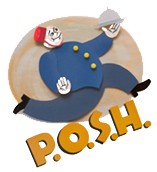Antique French Faïence Chinoiserie Pitcher
Antique French Faïence Chinoiserie Pitcher
$275.00
This exquisite Antique French Pitcher was found on our most recent trip to the antique markets of Paris. Dating from the mid-1800s, this striking pitcher, with its lush, hand-colored decoration is a lovely example of the European fascination during the 18th and 19th centuries with an Orientalist aesthetic. With captivating detail, the trompe l'oeil pitcher mimics a fabric bag cinched at both top and bottom with a terra-cotta hued "rope" which also forms the pitcher's arching handle.
The decoration on both sides of the pitcher is a finely detailed celebration of the Chinoiserie design aesthetic depicting fantastically exotic vignettes with thatched umbrellas and fanciful structures made of branches. A figure standing in a wide brimmed hat is on one side, while on the other side, with a wink and a nod, a seated figure is painting a sign with the name of the pottery company that produced this exceptional pitcher: Luneville Keller et Guérin. Trailing floral garlands dance across the pitcher adding to the organic, unstructured quality of the design.
Truly unique, this pitcher is sure to take pride of place in your home sharing its storied and dreamy aesthetic still today.
One-of-a-kind and subject to prior sale. In very good antique condition. Measures 8"H x 7" at the widest point.
Learn More About Chinoiserie
Back in the 17th and 18th centuries, when traveling the world was practically an impossibility for the general population, people relied on objects, artworks, and word-of-mouth to learn about the far-flung corners of the map. Thanks to a global network of trade routes, many cultures were getting to know one another for the first time not through physical meetings, but primarily through goods who sold them.
In Europe, an overwhelming fascination with China—and in particular, Chinese porcelain—developed among tastemakers, which fueled an immense demand for East Asian goods, particularly within the realm of the decorative arts. “European manufacturers took advantage of this craze by beginning to produce designs in imitation of the Chinese,” says Anca Lasc, Associate Professor in History of Art and Design at the Pratt Institute. Such goods—which ranged from furniture to textiles to fine art—featured Chinese materials (or imitations of them) such as porcelain and lacquer, plus Chinese motifs like pagodas, dragons, and flora as imagined through the highly fantastical Western lens.
“Chinoiserie was originally part of a desire for novelty and otherness in European design, which had long followed the rules of classicism and baroque design. Newly discovered cultures with brand new materials such as porcelain and lacquer naturally made a sensational splash,” says Dr. Aldous Bertram, an interior designer with a doctorate in chinoiserie from Cambridge University.
While the European taste for Chinese goods grew organically in Europe as traders brought them back, the tipping point in chinoiserie’s popularity was when King Louis XIV of France built the Trianon de Porcelaine—a five-pavilion structure bedecked with blue-and-white tilework—on the grounds of the Palace of Versailles in 1671. Ever the trendsetter, Louis’ fondness for chinoiserie—which included Chinese-style fashion—quickly spread throughout European courts, becoming a quite popular design style through the 18th century.
*Brief history of Chinoiserie courtesy of House Beautiful magazine
Learn More About Luneville Faience
In 1728 Jacques Chambrette established the first earthenware factory in the town of Lunéville, along the river Meuse in the Lorraine region of Eastern France. As a result of its economic and artistic success, the factory was awarded the status of Manufacture Royale de Fayence by the Ducs of Lorraine in 1749.
At the time, the Lunéville manufacture was one of the main rivals of the expanding English and German ceramics centers and Chambrette managed to successfully export his wares throughout Europe.
In 1786 Sébastien Keller bought Luneville from the Chambrette family and for the next 137 years, the Keller family controlled the company. About 1832, Sébastien Keller's son formed a partnership with his brother-in-law Guérin to give birth to the mark K&G (or KG) from the names Keller and Guérin.
By 1900, there were around 1,100 employees and the factory's products had a worldwide reputation. The Lunéville artisans were inspired by their surroundings; pieces were decorated with flowers, insects, real and fictitious animals and even exotic figures.
Times and fortunes change and by 1981, the studios of Luneville Faience were shuttered with their long and rich history coming to an end.























